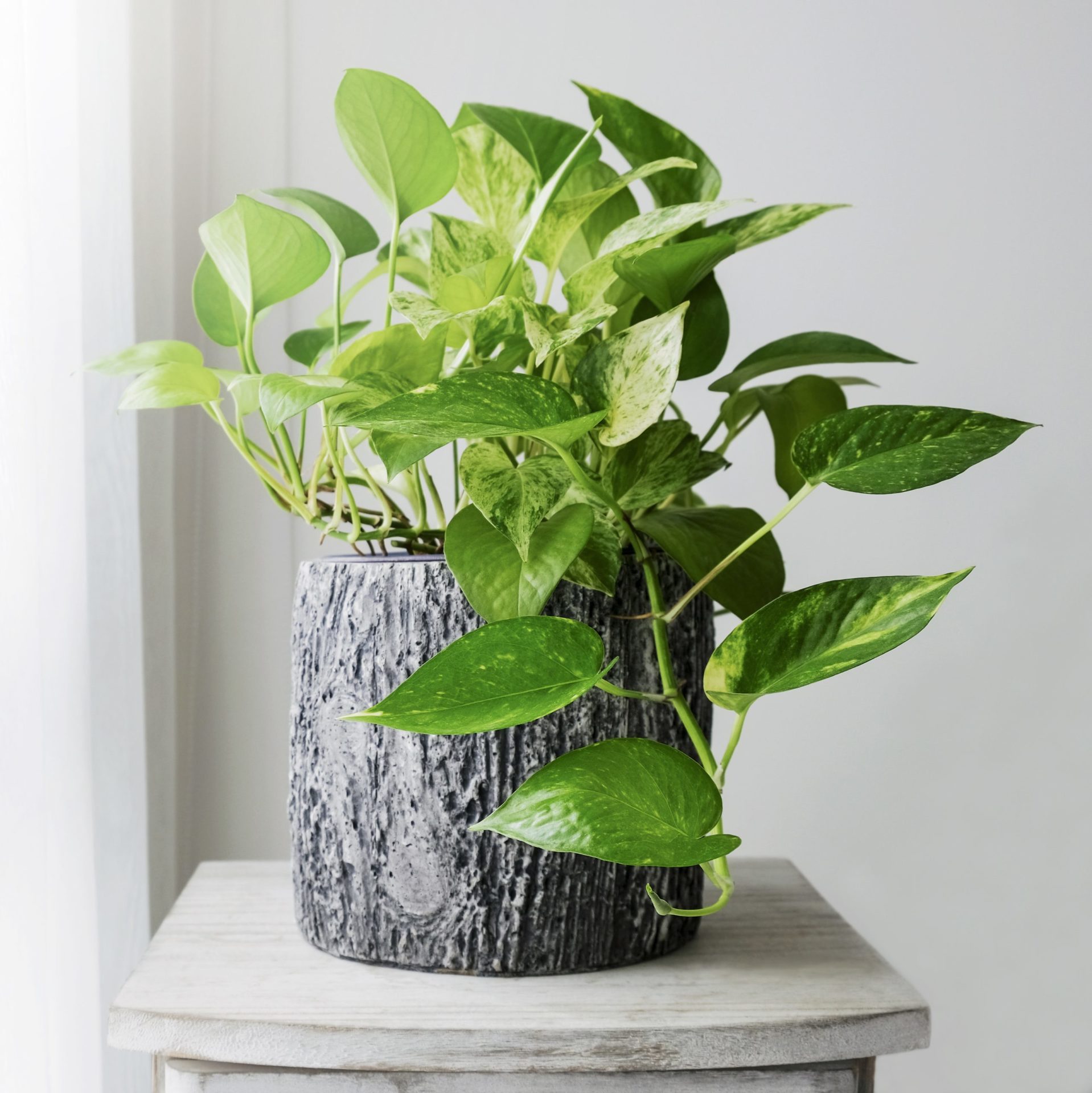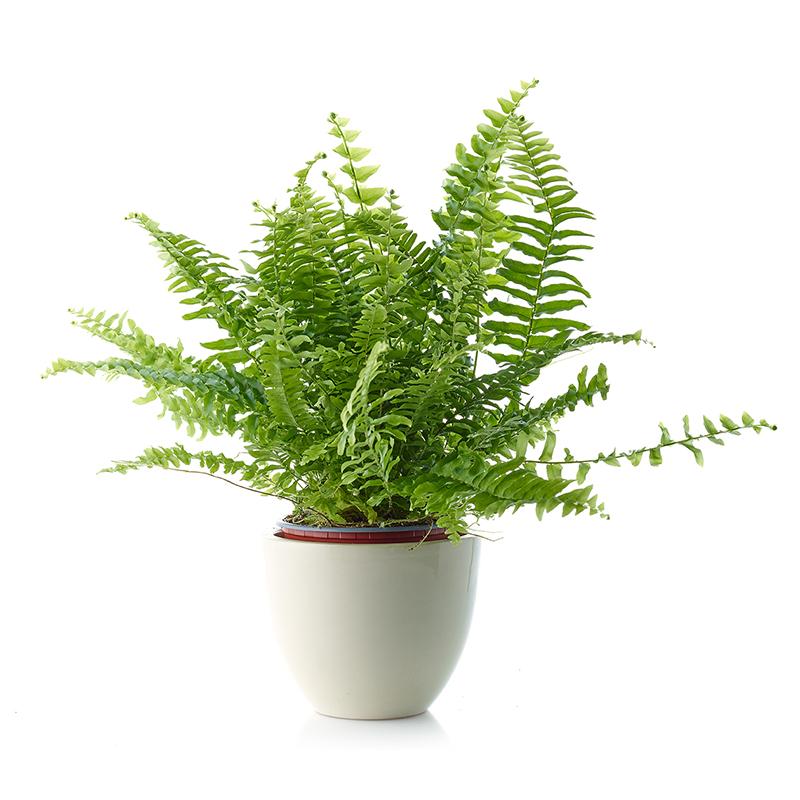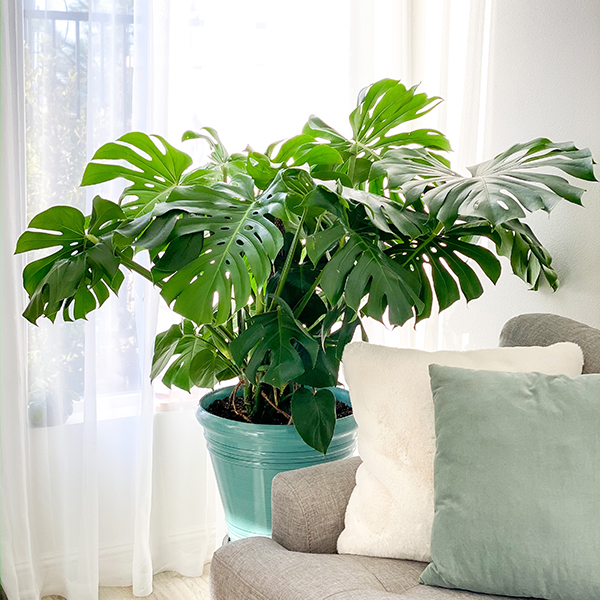Philodendron
Low light houseplants are perfect for frequent travelers or forgetful plant caretakers. One of the best indoor plant varieties, philodendron, is very tolerant of dark interiors. This fast-growing vine works well in hanging baskets or can be trained to climb a small trellis or totem. Two newer varieties offer colorful foliage. The ‘Brasil’ variety has gorgeous gold-and-green variegated foliage, while ‘Micans’ sports purple flushed leaves with a satin-like texture.
Light: Low light or indirect light
Water: When the soil is dry to the touch
Size: Trailing stems can reach up to 8 feet
Pothos
Often confused with Philodendron, pothos will thrive in any room of your home as long as you keep it out of full sun. It’s an easy-care vining plant that you can train onto a trellis or allow to tumble over the edge of a hanging basket.

Pothos comes in a variety of colors and bicolors, including dark green, chartreuse, white-and-green, yellow-and-green, and spotted silver.
Light: Low light or indirect light
Water: When the soil is dry to the touch
Size: Most will stay between 6 and 10 feet, but the trailing stems can reach up to 30 feet (prune it back to keep it smaller or if it’s looking leggy)
ZZ Plant
Looking for a houseplant that tolerates dark corners and neglect? Check out ZZ plant, Zamioculcas zamiifolia. This African native will do just fine even if it only gets fluorescent light in an office or shop. It also tolerates dry conditions, so it’s ideal for someone who travels frequently. The ZZ plant looks great, too; it produces upright, slightly arching stems covered in shiny, dark green leaves.
Light: Low light or bright, indirect light
Water: When the top of inch soil dries out
Size: Up to 3 feet tall
Palms
Popular since the Victorian era, parlor palm, Chamaedorea elegans, is a slow-growing Mexican native that does well in low-light situations. It grows 4 feet tall and makes a bold statement in any room. Parlor palm only needs to be watered when the soil feels dry to the touch, but it does help to mist the plants once in a while during the winter. Perfect for any room in your house, ponytail palm, Beaucarnea recurvata, is virtually indestructible. It’s a fascinating and unusual plant with long straplike leaves sprouting from a large, fat base that gives this plant its other common name, elephant’s foot palm. If you travel a lot, ponytail palm is ideal because the plant stores excess water in its chubby base, so it can go for several weeks without being watered. Ponytail palms are sold in a variety of heights from tabletop to tree-size, and can reach up to 6 feet indoors.
Boston Fern
Ever since they were first discovered in the late 1800s, Boston ferns, Nephrolepis exaltata, have played an important role in interior design.

These gorgeous plants develop bright green, arching fronds that look great in urns or baskets. Boston ferns thrive in partially shady indoor and outdoor locations away from cold drafts or heat ducts.
Like all ferns, they love humidity, so mist often during the winter to minimize leaf drop.
Light: Low light or indirect light
Water: When the soil is dry to the touch
Size: Up to 3 feet tall
Dieffenbachia
When it comes to colorful leaves, few houseplants offer as many options as Dieffenbachia. These gorgeous tropical plants feature a wide range of speckled or splotched leaves in either yellow-and-green or white-and-green. Although they grow well in dark rooms, they do prefer some bright, indirect light to keep them from getting too leggy. Dieffenbachia is poisonous, so keep it out of reach of children and pets.
Light: Low light or bright, indirect light
Water: When the top inch of soil is dry
Size: Up to 3 feet tall
Gloxinia
Although Gloxinia can’t survive in a completely dark room, it will bloom beautifully anywhere it can receive bright, indirect light away from full sun. A close relative of African violet, Gloxinia develops large velvety, trumpet like flowers in a variety of jewel-like colors. Use warm water and avoid getting the foliage wet. Feed once a month with a liquid houseplant fertilizer while the plants are in bloom.
Light: Bright, indirect light
Water: When the soil is dry to the touch
Size: Up to 12 inches tall
Monstera
Create a tropical getaway in your living room with Monstera adansonii. Occasionally called Swiss cheese plant, Monstera produces huge, bright green, attractively cut leaves. Monstera has a dense, bushy shape, but over time, it will begin to stretch and climb a trellis or wood totem. A small Monstera can even be repotted into a hanging basket. If you want to keep the plant compact, simply prune back the vining branches. Water Monstera whenever the soil feels dry to the touch, and fertilize once a month during the spring and summer.
Light: Indirect light
Water: When the top inch of soil is dry
Size: Up to 13 feet tall, though most will stay much smaller indoors.
Cast Iron Plant
Here’s a houseplant that truly lives up to its name. Cast iron plant, Aspidistra elatior, thrives on neglect and lives happily in dark rooms with only occasional watering. Plus, this rugged plant spreads slowly, so it rarely needs repotting. Cast iron plant produces dark green narrow leaves; there’s also a variegated form, but it can be difficult to find.
Light: Low light or indirect light
Water: When the soil is dry to the touch
Size: Up to 3 feet tall
Aglaonema
Over the past few years red Aglaonema has taken the houseplant world by storm. With spectacular bright green leaves, this houseplant will brighten even the darkest room, though you can also find varieties with red or even pink foliage. Aglaonema doesn’t mind dry soil either, so it makes a great gift for forgetful gardeners. Originally called Chinese evergreen, Aglaonema is almost foolproof.
Light: Low light or indirect light
Water: Water when the soil is dry to the touch
Size: Up to 3 feet tall
Peace Lily
Easy and elegant: That’s the best way to describe peace lily. This low-light houseplant sends up pure white flower spaths on tall, graceful stems. Peace lily also has shiny green foliage that looks great even when the plants aren’t blooming. Often sold under its botanic name, Spathiphyllum, peace lily makes a relatively undemanding houseplant.
Light: Low light or indirect light
Water: When the soil is dry to the touch
Size: Up to 36 inches tall
Prayer Plant
Brighten the dark corners of your home with the cheerful foliage of prayer plant, Maranta leuconeura. This easy-care charmer sports variegated green-and-cream leaves with bright red veins. It gets its name from the fact that the leaves fold up at night. Prayer plant only grows 6-8 inches tall, so it’s a good choice for an end table or bookshelf.
Light: Low light or indirect light
Water: When the soil is dry to the touch
Size: Up to 8 inches tall
English Ivy
Perfect for a hanging basket or urn, the trailing foliage of English ivy is a great choice if you want to lush up a dull room. English ivy comes in a wide variety of leaf colors and shapes and thrives in low light. In fact, it’s the perfect plant to grow on a cool, north-facing windowsill. You also can train English ivy into a variety of topiary shapes. English ivy can be bothered by spider mites, so mist the plants often to prevent these pests from gaining a foothold.
Light: Low light or indirect light
Water: Before the soil is dry to the touch
Size: Up to 8 feet
Dracaena
Dracaenas add a touch of elegance to any room of your home. This plant is often sold as a standard houseplant or in tree form, so you can cluster several together to create a miniature forest. To keep it looking its best, remove any faded leaves as they appear.
Light: Low light or indirect light
Water: When the soil is dry to the touch
Size: Up to 6 feet tall indoors
Arrowhead Vine
Native to Central America, arrowhead vine, Syngonium podophyllum, can tolerate a wide range of low-light conditions. Its handsome foliage can be bright green, bronze, or variegated. When young, arrowhead vine forms a bushy mound; over time the plants will begin to vine, making them ideal for hanging baskets or trained up a trellis or totem. Pinch your plants if they begin to get too leggy.
Light: Low or medium indirect light
Water: When the soil is dry to the touch
Size: Up to 3 feet
Peperomia
Perfect for terrariums or dish gardens, Peperomia grows only 4-10 inches tall and offers a wide selection of different leaf shapes and colors. It has few insect or disease problems, and it’s native to rain forests, so it likes to be in a spot with plenty of humidity.
Light: Low light or indirect light
Water: When the soil is dry to the touch
Size: Up to 10 inches tall
Moth Orchid
Add a touch of elegance to any room in your home with Phalaenopis, commonly called moth orchid. These easy-care beauties hold their blooms for up to four months and are ideal for low-light locations. Moth orchids come in a wide selection of colors and bicolors, and they’re generally sold in two sizes: Standards that grow 18-24 inches tall and dwarfs that stay under 12 inches in height. Moth orchids grow in bark or moss and should only be watered when that material feels dry. More orchids die from overwatering than under-watering, so don’t be afraid to let it get just a little dry.
Light: Low light or bright, indirect light
Water: When the growing medium is dry to the touch
Size: Up to 24 inches tall
Anthurium
The bold, red, pink, orange, white, or purple flowers of Anthurium are a welcome treat during the dark days of winter. These tropical beauties don’t like overly dry or wet soils, so it’s important to keep the soil slightly moist at all times. Anthurium blooms best in bright, indirect light, but will do just fine in darker situations, although flowering may be limited. However, the plants have bright green, heart-shape leaves that keep the color show going even when they are not in bloom.
Light: Low light or bright indirect light
Water: Just before the soil is dry to the touch
Size: Up to 2 feet tall
Spider Plant
Don’t let the common name of this amazing houseplant scare you off. Spider plant, also called airplane plant, gets its name from the many runners it sends out with baby plants at the tips. Available in dark green and variegated forms, spider plant, Chlorophytum comosum, makes a great tabletop or basket plant in low-light conditions. During the winter, mist the plants frequently to help prevent the leaf tips from turning brown.
Light: Low light or indirect light
Water: When the soil is dry to the touch
Size: Up to 12 inches tall
Yucca Cane
When you think of yucca plants, sunny desert conditions probably come to mind. But indoors, these plants are almost as happy in a dark corner where you can enjoy its leathery green, lancelike foliage and attractive tan bark. The plant won’t grow as quickly in a dark room as it does in a sunny spot, but it will be just fine as long as you don’t overwater it.
Light: Low light or bright indirect light
Water: When the soil is dry to the touch
Size: Up to 8 feet tall indoors
Begonia
The jewel-like leaves and flowers of begonia will turn any dark room into a festival of color. There are many species of begonia to choose from, but one of the best for growing indoors is rex begonia, which comes in different varieties sporting multicolor leaves in an assortment of silver, green, pink, red, orange, and burgundy. Growing only a few inches tall, rex begonias can also be used in terrariums or dish gardens. Rex begonias do best in soil that’s kept just slightly moist at all times.
Light: Low light or indirect light
Water: Just before the soil is dry to the touch
Size: Up to 8 inches tall
Columnea
Columnea develops tubular orange or yellow blooms that give these jungle natives their common name, goldfish plant. Although Columnea blooms best in a bright location, the plants themselves will thrive in darker rooms where its trailing, shiny, dark green leaves will be appreciated. Columnea makes a great basket plant.
Light: Low light or bright, indirect light
Water: When the soil is dry to the touch
Size: Up to 24 inches
Hoya
A gorgeous slow-growing vine, Hoya, or wax plant, thrives in bright indirect light, but does almost as well in darker locations. Hoya comes in either flat-leaved or crinkled- leaved forms and will occasionally produce clusters of highly fragrant white flowers. Flat-leaved Hoya also comes in solid green or variegated cream-and-green leaves. You can train a Hoya up a trellis or totem or allow it to trail over the edge of a pot or urn.
Light: Low light or bright, indirect light
Water: When the soil is dry to the touch
Size: Trailing vines can reach up to 4 feet
By Better Homes and Gardens Editors








